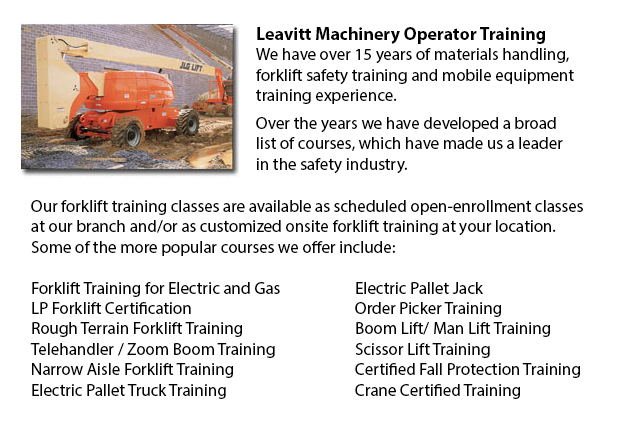
Mississauga Boom Lift Safey Training - Boom lifts are a type of elevated work platform or aerial lifting device which are normally utilized in construction, industry, and warehousing. Boom lifts can be made use of in virtually whichever environment due to their versatility.
The elevated work platform is utilized so as to enable access to heights that were otherwise not reachable utilizing other methods. There are dangers inherent when utilizing a boom lift device. Employees who operate them should be trained in the proper operating techniques. Accident prevention is paramount.
Boom Lift Training Programs include the safety factors involved in using boom lifts. The program is suitable for those who operate self-propelled boom supported elevated work platforms and self-propelled elevated work platforms. Upon successful completion of the course, participants will be issued a certificate by someone authorized to confirm the completion of a hands-on assessment.
To help train operators in the safe utilization of elevated work platforms, industry agencies, local and federal regulators, and lift manufacturers all play a part in establishing standards and providing the necessary information. The most important ways to avoid accidents connected to the utilization of elevated work platforms are as follows: conducting site assessments; checking machinery; and having on safety gear.
Vital safety factors when operating Boom lifts:
Operators stay away from power line, observing the minimum safe approach distance (or also known as MSAD). Voltage can arc across the air to be able to find an easy path to ground.
So as to maintain stability when the platform nears the ground, a telescopic boom should be retracted prior to lowering a work platform.
People working from the Boom lift platform should tie off to guarantee their safety. Safety harness and lanyard combinations must not be attached to any anchorage other than that provided by the manufacturer, never to other wires or poles. Tying off may or may not be required in scissor lifts, depending on particular job risks, local regulations, or employer guidelines.
The maximum slope would be specified by the manufacturer. Workers must avoid working on a slope, if possible. When the slope exceeds recommended conditions, the lifting device should be transported or winched over the slope. A grade can be measured easily by laying a minimum 3-feet long straight edge or board on the slope. Next a carpenter's level can be laid on the straight edge and the end raised until it is level. The per-cent slope is attained by measuring the distance to the ground (likewise known as the rise) and then dividing the rise by the length of the straight edge. Then multiply by 100.
-
Mississauga Crane Training Courses
Mississauga Crane Training Courses - The heavy equipment crane is intended to move, lift and lower heavy stuff. Normally, the crane comes outfitted along with a hoist, sheaves, and chains or wire ropes. Cranes are utilized in the manufacturing, const... More -
Mississauga Telehandler Ticket
Mississauga Telehandler Ticket - The telescopic handler or telehandler is a normally utilized machine in agricultural and industrial applications. This machine is the same in look to a forklift and even works in a similar way, even though telehandler... More -
Mississauga Overhead Crane Ticket
Mississauga Overhead Crane Ticket - An overhead crane is normally used in industrial environments. Likewise referred to as a bridge crane, this equipment includes parallel runways spanned by a traveling bridge. The component that lifts materials is t... More -
Mississauga Forklift Safety Training
Mississauga Forklift Safety Training - Any person who wants to operate a lift truck has to take a forklift safety training program in order to become a certified forklift truck operator. There are various ways to acquire forklift training. Courses ar... More -
Mississauga Heavy Equipment Training
Mississauga Heavy Equipment Training - Normally, the different kinds of heavy equipment training are divided into 2 categories of equipment: those that have rubber tires and tracked vehicles. Tracked vehicles include items such as excavators, cranes,... More -
Mississauga Loader Ticket
Mississauga Loader Ticket - Loaders have been created to operate practically anywhere. They offer optimal traction and maneuverability because of a heavy-duty oscillating joint which offers 45-degree rotating angles toward the left and right, with 10... More -
Mississauga Boom Lift Certification
Mississauga Boom Lift Certification - Elevated work platforms allow maintenance operations and work to be done at levels which can not be reached by whichever other means. Boom Lift Certification Training educates workers about safely operating boom... More -
Mississauga Forklift Training School
Mississauga Forklift Training School - Why A Forklift Operator Must Take A Forklift Training School - Federal and industry regulators have established the criteria for forklift safety training based on their existing standards and regulations. People... More

Forklift Certification Mississauga
TOLL FREE: 1-888-254-6157
Mississauga, Ontario
forkliftcertificationmississauga.com
Email Us
About Us


